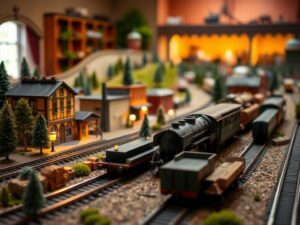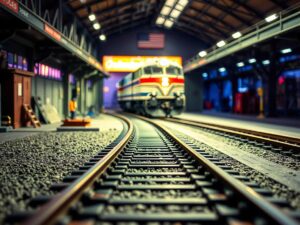Creating Bridges and Tunnels in HO Scale Layouts
Creating Bridges and Tunnels in HO Scale Layouts
Building Bridges to Awesome: Crafting HO Scale Bridges & Tunnels
Hey there, fellow railfans! Welcome back to the track! Today, we’re diving into one of the most visually captivating and technically fascinating aspects of model railroading â crafting realistic bridges and tunnels for your HO scale layouts. Whether you’re a brand-new enthusiast or a seasoned builder, this deep dive will equip you with knowledge and techniques to elevate your layout to the next level.
Why Bridges & Tunnels? They’re More Than Just Track Lifts
Bridges and tunnels aren’t just about getting your trains over or through obstacles; they add an element of grandeur and drama to your miniature world, enhancing its realism and storytelling potential. Imagine a majestic truss bridge spanning a glistening river or a shadowy tunnel shrouded in mystery â these features transport your viewers into your meticulously crafted railway scene.
Understanding HO Scale Construction
Before we embark on building bridges and tunnels, it’s crucial to understand the scale. In HO scale (1:87), everything is miniature, from tiny locomotives to passengers crammed onto scaled-down seats. When building bridges and tunnels, accuracy and detail become paramount to maintaining that authentic feel. Luckily, a wealth of readily available kits and supplies cater specifically to HO scale enthusiasts.
Mastering the Bridge Building Arts: Types & Construction
-
Beam Bridges: Simplicity Meets Functionality
- This type features horizontal beams resting on piers or supports, perfect for shorter spans. Think rural bridges across quiet streams. They’re great starting projects!
-
Arch Bridges: Graceful Strength in Motion
- Utilizing a curved structure that transmits the load to its supports, arch bridges lend elegance and durability. Ideal for wider spans, think majestic crossings over valleys or railways lines.
-
Truss Bridges: A Masterclass in Efficiency
- Composed of triangular frameworks called trusses, these bridges offer impressive strength with lightweight construction. Often associated with larger spans, they make for stunning focal points on your layout.
Tips for Realistic HO Scale Bridges:
- Detail is Your Friend: Use fine sandpaper to smooth out seams and add details like railings, lighting, and warning signs. Small brass wire can be twisted to form railings. Consider adding small rivets using a punch and pin for a truly detailed look.
- Paints Bring the Realism: Invest in weathering paints and techniques â imagine rust, chipped paint, and grime. Experiment with airbrushing for smooth gradients and dry brushing to accentuate texture.
Delving into the Depths: HO Scale Tunnel Construction
Tunnels are a great way to add mystery and intrigue to your layout. While more involved than bridge construction, they’re rewarding and achievable.
Key Stages:
1. Planning & Layout: Map out the tunnel entrance and exit locations on your track plan. Remember ventilation is crucial, so consider incorporating vents for realism.
2. Cutting & Shaping: Use sturdy plastic foam sheets or craft wood as the foundation. Mark out your tunnel dimensions and cut carefully. Utilize sharp utility knives and carving tools to achieve the desired curves and shape.
-
Lining & Detailing:
- Create a realistic tunnel interior by layering textured wallpaper, craft foam, or even paper pulp. Paint the walls in shades of grey or darker browns for an authentic look. Add flickering LED lights (available from most hobby shops) to simulate ventilation shafts and give your tunnels depth and drama.
Pro Tip:
Consider adding scenery elements inside the tunnel â think fallen leaves, rockslides, or even miniature trains on hidden tracks. This elevates the visual impact and makes it more captivating for viewers.
Realistic Realism: Common Mistakes to Avoid
- Underestimating Scale: Too-large bridge piers or tunnel sections will throw off your layout’s authenticity. Remember to meticulously measure according to your HO scale model and plan ahead.
- Neglecting the Scenery: Bridges and tunnels shouldnât stand alone! Surround them with lush vegetation, weathered stones, or even miniature buildings to make them feel integrated into their environment.
Conquering Your Own HO Scale Projects
We’ve explored the exciting world of HO scale bridges and tunnels! Remember, these are your creative masterpieces â have fun, experiment, and learn from every step. Start small, focus on detail, and most importantly, share your projects with other rail enthusiasts online and in-person. The community is what makes this hobby so special!
Now, go out there, build some awesome structures, and remember, every rivet placed and every brick laid brings you closer to crafting the miniature railway world of your dreams!




